Who tells our story?
An article by David Hechler ’72 examines the significance and evolution of Grinnell College Memory Books.
February 28, 2023 — I remember when I first heard about Grinnell College Memory Books. I was on campus to start preparing for our 45th reunion. I was chatting with someone from the Office of Development & Alumni Relations, who was helping us plan it, when she casually mentioned that it wouldn’t be long before I’d be working on a Memory Book. “What’s a Memory Book?” I asked. She started to explain that it’s a project undertaken by the 50th reunion class, but then she thought better of it. “I’ll send you one,” she said.
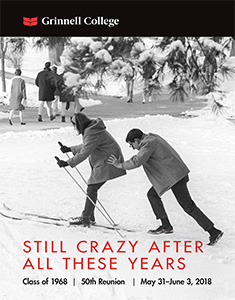 1968 Memory Book cover
1968 Memory Book cover
Some weeks later, when I opened the package and leafed through the large paperback volume she’d sent me, I was immediately intrigued. “Still Crazy After All These Years,” created by the class of ’68, is a 257-page buffet of Grinnell events and anecdotes, mostly served up in small and beautifully prepared portions. It started with a timeline of words and images that traced their four years on campus. Many of the events were drawn from news items and photos in the Scarlet & Black. To add context, each academic year began with “What Happened at Grinnell,” followed by “What Happened in the United States and the World.” The latter tended to focus on events that represented political and social change. Also disproportionately represented were announcements of new books, record albums, and films that were popular with students.
The timelines set the scene. They brought readers back to the era and place. But what followed was the heart of the book. It wasn’t pulled from old Scarlet & Black newspapers or yearbooks. It was original writing by members of the class of 1968 about their college experience from the vantage of 50 years. The editor, Sara Dreyfuss ’68, had used her class listserv – sending out questions every week or so – to encourage her classmates to address almost two dozen topics she’d chosen. These short chapters featured a wide array of subjects: how they came to choose Grinnell, dorm life, dating, entertainment on campus, the weather.
Their responses were tightly edited. Most were a single paragraph. There was a lot of laughter in those pages, but plenty of serious entries as well. The chapter on downtown Grinnell revealed that Black students and faculty had been verbally harassed and physically attacked there. (One white alum pronounced himself shocked – and embarrassed – that he’d never known.) Other entries discussed what they did to avoid studying, the second-class status of women on campus, and professors who’d changed students’ lives. Kathryn Buck ’68, the photo editor recruited to work with Dreyfuss, found images to illustrate the anecdotes, just as she’d done for the timelines. The images injected a visual verve that kept me turning the pages.
Backstory
There have been nine Grinnell Memory Books published so far. I helped edit the most recent one produced by the class of ’72. By the time we handed it out at our reunion last June, the six of us who edited it had labored for 10 months. We had the ’68 book and three others to study as models. And when we finally finished, I was curious how this whole thing got started.
I knew where to find the answer. As I sat in a New York airport the day before our reunion, waiting for my flight, I texted Jayn Bailey Chaney ’05, director of alumni and donor relations. She’d guided us through the process, putting in long hours herself, just as she’d done for the other classes. She texted right back, agreeing to tell us the story at the Hotel Grinnell bar that night.
Her reunion project began when she was hired in 2012. Back then, the College strove to help all reunion class committees create what were called reunion directories. Alums were asked to fill out questionnaires from which bios were compiled for all who participated. These were turned into books (or sometimes CDs) that were handed out on campus to the returning classes. The work could be arduous, so the College hired a student to help each class with the work.
Chaney decided to change this approach. “In 2013,” she explained, “we stopped the practice of doing the directories for all the other classes. And the only class we did it with was the 50th reunion.” The idea was to cut the extra work for regular reunions and turn the 50th into something special. She encouraged the class of ’63 to get creative and see what they could do.
Directories
 1963 Grinnell directory cover
1963 Grinnell directory cover
Jeannie Thompson Parker ’63 was formerly the class agent for the class of 1963. She knew how to encourage her classmates to contribute. She worked the phones, she told me. And other committee members did the same. She’d had a lot of experience putting together high school yearbooks, and she’d overseen previous Grinnell directories, so she felt confident. And Chaney saw results that were impressive and innovative.
Parker and her colleagues compiled a 241-page book that included a timeline – in fact two. One covered events in the world during their senior year; the other listed activities on campus. That was new. There was a cover, a spiral binding, and autobiographical essays. Each was accompanied by an old photo and sometimes a new one. Biographical memorials (with photos) were written by the friends of deceased classmates. This was also new.
There was a lot to like. But having been steeped in a different approach, it was hard for me to embrace the format. Some of the bios read almost like resumes. Others were vivid essays that brimmed with life. Still others were short squibs.
The one by “DuWayne Frankhouse” caught my eye. “Address Classified,” he wrote. “Email Redacted.” “O’ Grinnellians,” he began, “as I gaze out the window of my private dacha at an undisclosed location somewhere in the former Soviet Union, I reminisce about those halcyon days at Grinnell. I think back to those Iowa cornfields that rolled on and on and on and on and on and on.” By turns acerbic, wacky, and loving, his recollections would have fit into any of the Memory Books (though no one has ever used a pseudonym).
But that was an aberration. The main focus of the directories, including the one by the class of ’63, was: What have you been doing since? That changed the following year, when the class of ’64 asked for the first time: What were we doing then?
Chaney thought this was when Grinnell parted company with other schools that create publications for 50th reunions. She told me that some schools hire outside vendors to send out questionnaires and put together their books. I spent time trying to find ones that do what we do. I couldn’t. They all seemed to be creating directories, though some add a question or two encouraging alums to recall people and events from college. And some depend on alums to gather the information.
Turning the Page
Ellen Thompson Luepker ’64 was the chair of the first Memory Book project, but she didn’t take credit for initiating the leap. In the book she credited Barbara Taylor Tabbert ’64 for hatching the idea of creating a Memory Book and for assembling a Memory Book committee. Tabbert also selected photos from the archives, which was another big change. The stories the class wrote were complemented by images from their college years.
The most important innovation was how they solicited contributions. Luepker thanked Kate Scanlon Budlong ’64 for sorting and organizing 1,300 emails, and Marilyn Alt Scholl ’64 for compiling a list of themes and stimulating conversations on the class listserv.
The listserv was key, but they didn’t recognize this right away. Early on they used their class letter and emails to solicit contributions. In mid-October, they began to panic. They had only 18 pages of text from 35 classmates. The group called a meeting to discuss how they could stimulate more discussion. That’s when they decided to try their listserv.
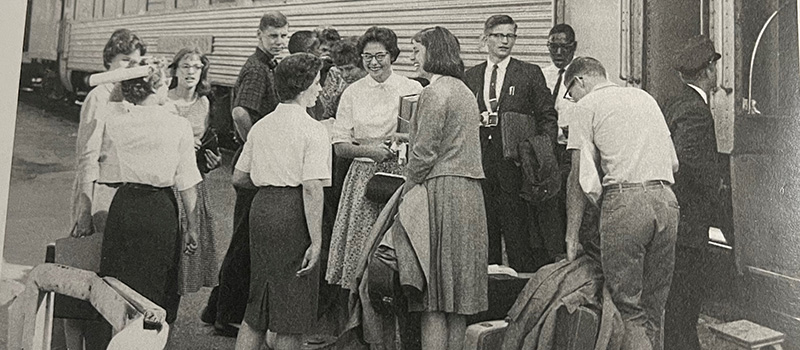 An image taken from the 1964 Memory Book shows Grinnell students disembarking a train to arrive in town.
An image taken from the 1964 Memory Book shows Grinnell students disembarking a train to arrive in town.
It was exactly the right tool. Emails from classmates were useful, but each one was a monologue sent to an editor. A message posted on the class listserv was a comment that could be seen by every classmate signed on. Each one could inspire responses. Instead of a book filled with individual recollections, the Memory Book would feature conversations. Classmates could agree, disagree, veer off on tangents, joke, provoke, lament, affirm. Some chapters read almost like old-fashioned bull sessions in a dormitory lounge.
It didn’t hurt that Luepker was a therapist who had extensive experience encouraging individuals to participate in oral history projects. When her group was developing questions to draw out their classmates, she asked her son, Carl Luepker ’95, to suggest topics to broaden the mix. The range of subjects was remarkable – especially since the organizers didn’t have previous Memory Books to consult for ideas. The final product had timelines. There were stories about dorm life, housemothers, professors, deceased classmates, extracurricular activities. There was even a chapter for entries that didn’t fit into the ones prescribed.
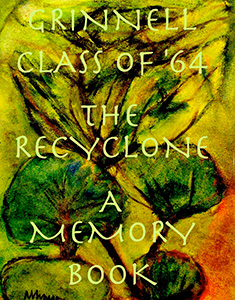 1964 Memory Book cover
1964 Memory Book cover
The editors also made room for longer pieces. One of my favorites was short-story length. The writer, George Wallace ’64, recounted hitchhiking with his four friends to Missouri. “We were all writers,” Wallace explained. “We believed in Jack Kerouac and the beats. We believed we could forge our lives to serve our art.” The wild trip that followed was their 46-hour version of On the Road (complete with a blues song they made up while waiting for a ride). What distinguished this entry and many of the others was the honesty and openness with which so many writers embraced the challenge. The quality of the topics doesn’t mean much if nobody runs with them.
They called the book The Recyclone (a nod to the yearbook – The Cyclone – that Grinnell still publishes), but they could have called it “Proof of Concept.” The Memory Book wasn’t just born, it was established.
Refinements
Author David Hechler ’72 created a video tour of a 1972 Grinnell Reunion Memory Book created for Reunion 2022. View the video.
Each Memory Book is unique, but they share common elements. They have timelines and chapters accompanied by photographs. Most also include “The Little (Scarlet and) and Black Book” (aka “The Herd Book”) that shows the entering class and a chapter that acknowledges alumni who have died. For years the layouts were done by College employees, and the printing was outsourced. Now outsiders do both under College staff direction.
The memories have continued to provide the book’s foundation. What makes them work is the quality of the writing. Year in and year out, it’s been very good. A testament to the liberal arts education we received is that this is true whether the writer majored in English or chemistry.
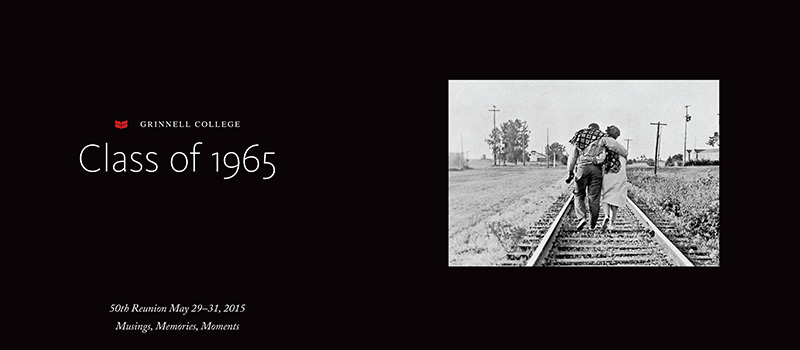 Front and back cover of the 1965 Grinnell Memory Book
Front and back cover of the 1965 Grinnell Memory Book
In retrospect, the groundbreaking 1964 book had one deficiency. It was the first book to introduce images, but it did not include very many. The ones the committee printed were mostly small, and they were all black and white. The big contribution the class of 1965 made was to change that. When Chris Verner Coolidge ’65 became its facilitator, she recognized that she needed help in this area, so she recruited Dixi Wetterling Carrillo ’65 to be her photo editor. Carrillo, a life-long photographer whose day job included helping to choose images for books, immediately saw the problem. The 1964 volume had 227 pages and 34 images. When she started her picture search, it just so happened there was an additional tool: The Scarlet & Black digital archive was newly available.
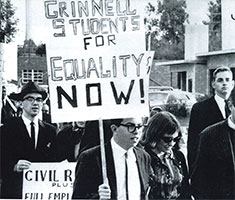 Image from the 1965 Memory
Image from the 1965 Memory
Book features Grinnellians
marching for equal rights
on the streets of Grinnell.
The '65 book has 185 pages and 205 images. Each section begins with a title page facing a full-page photo. The campus timeline is much expanded and, unlike the ones the two previous classes designed, it includes lots of photographs. And there’s color. There are also attractive new design elements. Passages of text are broken out in a large, bold font – some in scarlet and some in black, to emphasize the school colors.
If ’65 sent the photo memo, ’66 got it. In fact, every subsequent class filled their books with plenty of photos. They were recognized as essential ingredients. But it wasn’t as though classes started recruiting photo editors. Only a few had designated photo editors. And that should not be surprising.
When 50th reunion committees were established, Chaney knew that finding Memory Book volunteers was important, but there was no formal effort to recruit individuals with relevant professional experience. Some volunteers who stepped forward had valuable skills. Dreyfuss, who edited the ’68 book that was filled with snappy text, was the editorial director of the World Book Encyclopedia. But she and photo editor Buck were exceptions. Most editors did not have that kind of experience, and there was no prerequisite. But this did not pose a problem. The key performers weren’t the editors; they were the writers. As long as editors managed to reach their classmates and inspire them to send in stories, they didn’t need extraordinary editorial skills.
 1966 Memory Book cover
1966 Memory Book cover
Based on the job they did, Phyllis Lichtenberg Anderson ’66 and Carrie Smiley Frederick ’66 were well qualified to edit the 1966 book. But they didn’t volunteer to show off their expertise. They agreed to do it, they told me, because they thought they could work well together, and they feared that if they didn’t take the job, Ruth Koehler Bergerson ’66, who had been their class agent for 35 years, would. And they couldn’t let her shoulder that burden. As it turned out, Bergerson contributed plenty. But five other classmates were also credited with pitching in.
The next breakthrough was on timelines. The class of ’67 greatly expanded the one they devoted to world events. They gave it even more space than the campus events. Hank Balikov ’67, who was one of the editors, remembers that was a big part of an early discussion. He was asked to do much of the research. He also contributed lots of memories. One topic he explored was the glaring need for mental health support on campus. That subject resonated with me. We hadn’t planned to include it in our book, but a number of my classmates wrote long and remarkably candid entries about their own struggles, and the dearth of services on (and off) campus.
 1967 Memory Book cover
1967 Memory Book cover
Big topics like that one added depth to books and helped document the school’s history. But some of the essays that readers remember are short, quirky ones that make you smile. The 1967 book had a perfect example. Bill Shipton ’67 was writing a paper for a class on his prized electric typewriter when he discovered a problem. His fancy machine had lost the ability to type one letter. “In maybe my most creative writing product ever,” he continued, “I wrote the paper without using an M.” It was harder than you might think, he added. But he was able to buoy his spirits: “I kept reminding myself it wasn’t the E.”
Recent Tweaks
The 1968 book, as I noted earlier, professionalized the product. The class of ’69 shook things up. Ann Kirschner ’69 was the main editor, and she had a different vision. “I didn’t want it to be any kind of boilerplate publication,” she told me. There was no campus timeline like the ones that had become standard. Instead, there was “A Grinnell Christmas Poem” which explained to J.B. Grinnell how the dorms came to be “open” to both sexes. The timeline of world events included no photographs. The memory chapters were often short and featured far fewer photos than earlier books.
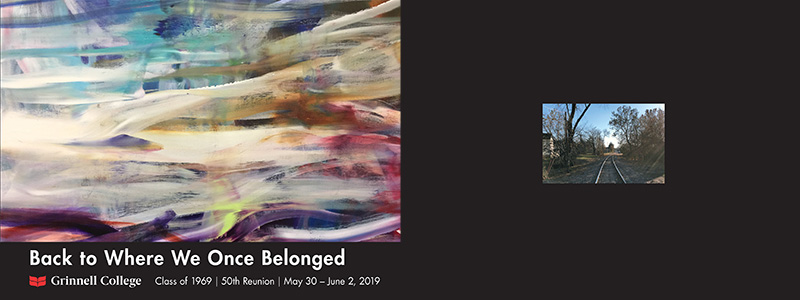 Front and back cover of the 1969 Grinnell Memory Book
Front and back cover of the 1969 Grinnell Memory Book
The vast majority of images were in the second half of the book, and Kirschner used them to develop her guiding theme. “I found it fascinating to look back and see what had changed and what had remained the same,” she told me. In a chapter called “The Way We Are Now,” recent photographs showed alums doing things they enjoyed with family members or with fellow alums. Captions provided updated information about them, which made each feel like a mini-directory. Continuing the theme in a way no other book had done, “The Campus Over Time” showcased the College’s physical transformation in maps, aerial photos, and shots of buildings. Historic photos of the town followed.
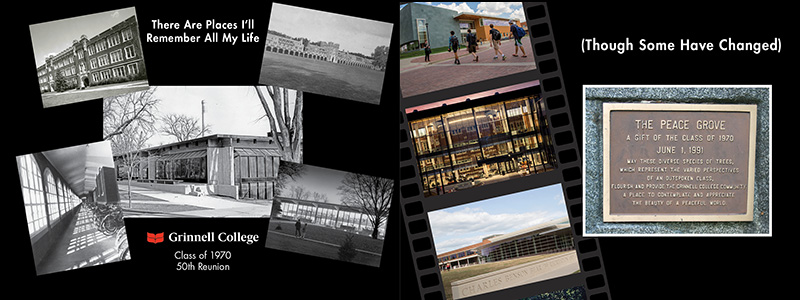 Front and back cover of the 1970 Grinnell Memory Book
Front and back cover of the 1970 Grinnell Memory Book
Before I tell you about the biggest book, I must acknowledge its creators’ place in history. The class of 1970 is forever fated to live in interesting times. Their graduation was canceled when the College closed to protest the Vietnam War, and their 50th reunion was twice delayed due to COVID. The 389-page volume they produced included, in addition to classmates’ comments, contemporaneous documents that captured key moments in the College’s history. There were articles from the S&B, covers of Grinnell’s underground newspapers, the first newspaper published by Concerned Black Students, and documents about the school’s closing. The editors also expanded the previous class’s effort to resurrect the directory. But they didn’t limit the endeavor to pictures and captions; they published updated headshots and asked their classmates to recount the highlights of their lives.
I asked Jon Andelson ’70, one of the book’s five editors, whether the book swelled to nearly 400 pages as a result of having more time. That wasn’t the case, he responded. The book was published long before their reunion. There was a simpler explanation. When the editors discussed ideas, there was no editor-in-chief who played gatekeeper. “Almost everything that popped into somebody's mind, we would say, ‘Yeah, let's do that,’” Andelson recalled. “At some point we went to Jayn [Chaney] and asked, ‘Is this too much?’ And she said, ‘We'll find a way.’” Andelson thought the historical archive his class compiled was of great value. He seems qualified to pass judgment. He’s got a Ph.D. in anthropology and has been a tenured professor at Grinnell since 1980. But “the heart of the book” he added, were his classmates’ responses to the questions on the listserv.
 1971 Memory Book cover
1971 Memory Book cover
The class of ’71 also had a delayed reunion and a bumpy path. Their project spanned the 2020 election and the Jan. 6, 2021 insurrection. Some of the discussions on the listserv grew heated. Becky Davis Kemmerer ’71, who was the main editor, wanted to keep the communication lines open, but eventually decided they had to take action. “There was a little polite back and forth for a while,” she told me. “Then it got not polite.” Listserv discussions start with ground rules, and the most basic is no personal attacks.
The book followed the lead of its predecessor by adding a lot of recent photographs at the end, but there was no dalliance with a directory. As usual, memories were the heart of the book. Kemmerer wrote something that captured the prejudice that women faced. She was a sophomore in Biology 101 when a freshman gave a wrong answer in class. Kemmerer raised her hand and corrected him. “Seemed fine; class went on,” she wrote. But as it ended, an upperclassman she knew well came up and let her have it: “Why’d you do that? You verbally castrated him!” She felt “terrible, embarrassed” … and annoyed. “It reinforced for me the notion that it was OK to be smart but not smarter than the boys.” Fifty years later, she remembers it well.
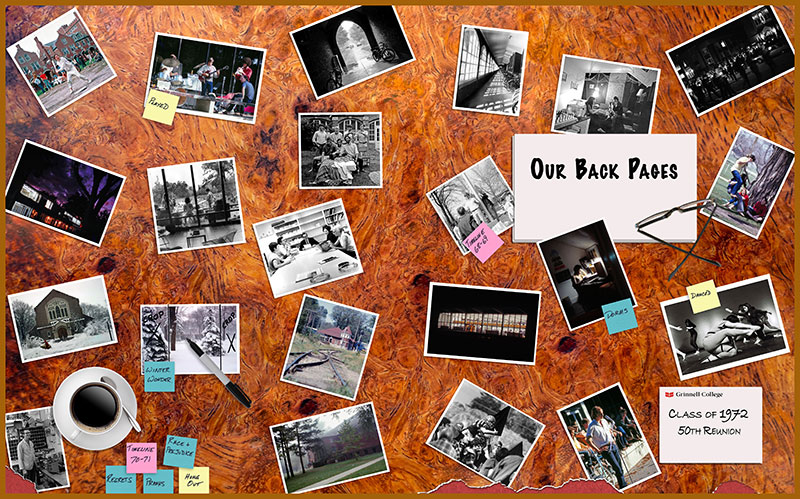 Front and back cover of the 1972 Grinnell Memory Book
Front and back cover of the 1972 Grinnell Memory Book
That brings us to ’72, our turn. One strength of the ’71 book was that writers often spoke to each other, making it feel as though they were sitting in the same room. An innovation we introduced was to incorporate actual conversations. Fearing we might not have enough material, we invited our classmates to join us on Zoom. We had a 30-minute video conversation in breakout rooms, and then reshuffled the deck and sent everyone back for another 30 minutes in a new group. All participants were told in advance that the sessions would be recorded, transcribed, and likely used in the book, which they were. In fact, we advertised them as a way to contribute if you preferred to talk instead of write. We also had beautiful timelines created by Mitch Erickson ’72 and Lynne Siemers ’72 that led to a timeline of major concerts on campus (another first). Nancy Mills ’72 sent classmates our weekly questions on the listserv and organized the responses; Celia Millington-Wyckoff ’72 proofread them all; and Chris Anderson ’72, our photo editor par excellence, created incredible covers (front, back, and inside) and so much more.
Why Do We Do This?
For Grinnell College, the benefits seem clear. Creating these books can’t help but increase alumni engagement with the school. Which makes it much more likely that more of us will attend the 50th reunion.
But if that were all they meant, Grinnell would have been wise to stick with directories. They were a lot less work for everyone, particularly the folks on campus. Chaney has devoted long hours helping us plan, design, solicit contributions, dig up information, unearth photographs, resolve creative disputes, lay out pages, proofread text, and fix mistakes.
I suggest there are three rewards our whole class got from creating our Memory Book, even though I doubt many of us thought about them when we were doing it. Writing about our memories was an easy way to contribute to the reunion. And it was the only way we ended up with a book. An alum could decide not to go to the reunion and still contribute by sending in a few memories.
The second was something I only thought about after our reunion. I was waiting in line in Darby Gym for the photographer to take our class picture when one of my classmates came over to chat. I told her the reunion was moving too fast. We’d only just gotten there, and it was almost over. She agreed, and then she said, “In some ways I feel like we already had our reunion.” I nodded, but I didn’t really understand what she meant until I was home. We’d spent months talking to each other on the listserv. We’d told each other things we’d never said before. We’d addressed serious topics and worked through emotional experiences and disagreements. We’d had a lot of laughs. And we’d had a chance to take a good long look at each other from a distance of 50 years. It was much more than anything that could happen during a couple of days on campus.
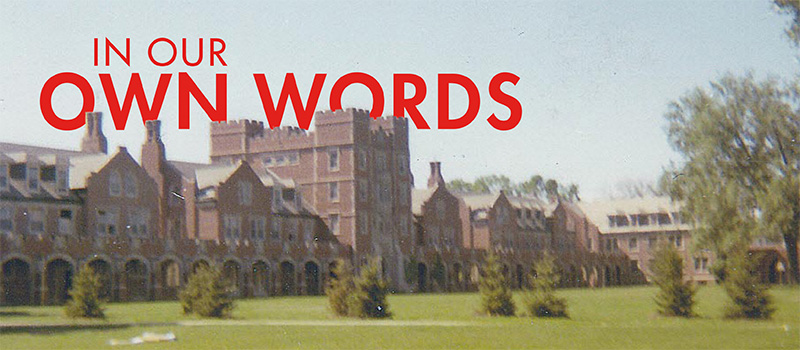 From the 1971 Memory Book
From the 1971 Memory Book
And that brings me to number three. What we really did was write a group memoir. It was our first chance to tell our story. And not just tell it but see it through our collective eyes. It was not something we could have done at the time, when we were doing our best to live it, to get through it. But from this vantage, and with an open invitation and lots of encouragement, we did something important. We compared notes. And each time we contributed a memory, we learned something about ourselves (the way you always do when you sit down to write), and we received more memories and insights in return. I have a much deeper understanding of what I lived through.
Each 50th reunion class the past decade has told their story in these books. They’re worth reading. They’re our history, and part of the history of Grinnell College. I hope someday they’ll be available for everyone to see. And if you haven’t contributed yet, stay tuned. Your time will come.
– By David Hechler ’72